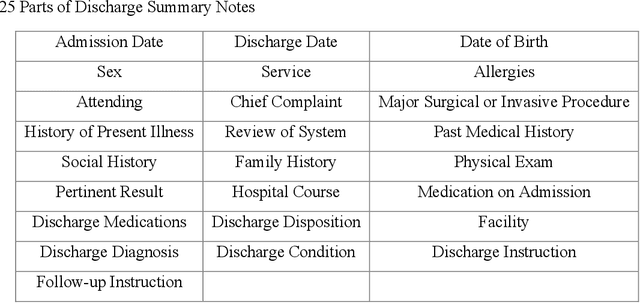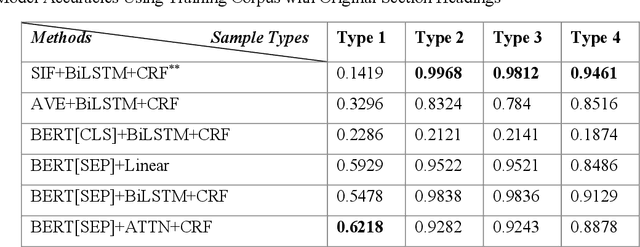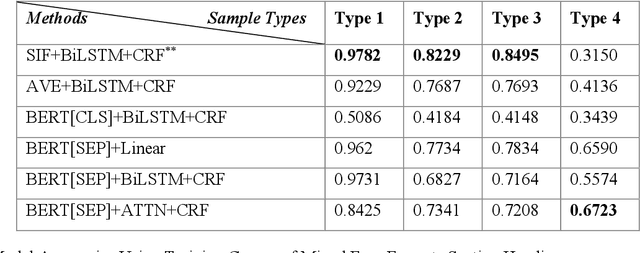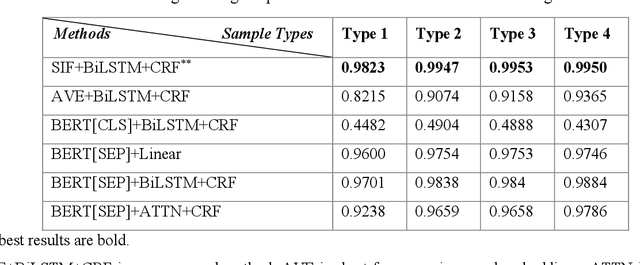Sheng Yu
DR.EHR: Dense Retrieval for Electronic Health Record with Knowledge Injection and Synthetic Data
Jul 24, 2025Abstract:Electronic Health Records (EHRs) are pivotal in clinical practices, yet their retrieval remains a challenge mainly due to semantic gap issues. Recent advancements in dense retrieval offer promising solutions but existing models, both general-domain and biomedical-domain, fall short due to insufficient medical knowledge or mismatched training corpora. This paper introduces \texttt{DR.EHR}, a series of dense retrieval models specifically tailored for EHR retrieval. We propose a two-stage training pipeline utilizing MIMIC-IV discharge summaries to address the need for extensive medical knowledge and large-scale training data. The first stage involves medical entity extraction and knowledge injection from a biomedical knowledge graph, while the second stage employs large language models to generate diverse training data. We train two variants of \texttt{DR.EHR}, with 110M and 7B parameters, respectively. Evaluated on the CliniQ benchmark, our models significantly outperforms all existing dense retrievers, achieving state-of-the-art results. Detailed analyses confirm our models' superiority across various match and query types, particularly in challenging semantic matches like implication and abbreviation. Ablation studies validate the effectiveness of each pipeline component, and supplementary experiments on EHR QA datasets demonstrate the models' generalizability on natural language questions, including complex ones with multiple entities. This work significantly advances EHR retrieval, offering a robust solution for clinical applications.
Evaluating Entity Retrieval in Electronic Health Records: a Semantic Gap Perspective
Feb 10, 2025



Abstract:Entity retrieval plays a crucial role in the utilization of Electronic Health Records (EHRs) and is applied across a wide range of clinical practices. However, a comprehensive evaluation of this task is lacking due to the absence of a public benchmark. In this paper, we propose the development and release of a novel benchmark for evaluating entity retrieval in EHRs, with a particular focus on the semantic gap issue. Using discharge summaries from the MIMIC-III dataset, we incorporate ICD codes and prescription labels associated with the notes as queries, and annotate relevance judgments using GPT-4. In total, we use 1,000 patient notes, generate 1,246 queries, and provide over 77,000 relevance annotations. To offer the first assessment of the semantic gap, we introduce a novel classification system for relevance matches. Leveraging GPT-4, we categorize each relevant pair into one of five categories: string, synonym, abbreviation, hyponym, and implication. Using the proposed benchmark, we evaluate several retrieval methods, including BM25, query expansion, and state-of-the-art dense retrievers. Our findings show that BM25 provides a strong baseline but struggles with semantic matches. Query expansion significantly improves performance, though it slightly reduces string match capabilities. Dense retrievers outperform traditional methods, particularly for semantic matches, and general-domain dense retrievers often surpass those trained specifically in the biomedical domain.
GENIE: Generative Note Information Extraction model for structuring EHR data
Jan 30, 2025Abstract:Electronic Health Records (EHRs) hold immense potential for advancing healthcare, offering rich, longitudinal data that combines structured information with valuable insights from unstructured clinical notes. However, the unstructured nature of clinical text poses significant challenges for secondary applications. Traditional methods for structuring EHR free-text data, such as rule-based systems and multi-stage pipelines, are often limited by their time-consuming configurations and inability to adapt across clinical notes from diverse healthcare settings. Few systems provide a comprehensive attribute extraction for terminologies. While giant large language models (LLMs) like GPT-4 and LLaMA 405B excel at structuring tasks, they are slow, costly, and impractical for large-scale use. To overcome these limitations, we introduce GENIE, a Generative Note Information Extraction system that leverages LLMs to streamline the structuring of unstructured clinical text into usable data with standardized format. GENIE processes entire paragraphs in a single pass, extracting entities, assertion statuses, locations, modifiers, values, and purposes with high accuracy. Its unified, end-to-end approach simplifies workflows, reduces errors, and eliminates the need for extensive manual intervention. Using a robust data preparation pipeline and fine-tuned small scale LLMs, GENIE achieves competitive performance across multiple information extraction tasks, outperforming traditional tools like cTAKES and MetaMap and can handle extra attributes to be extracted. GENIE strongly enhances real-world applicability and scalability in healthcare systems. By open-sourcing the model and test data, we aim to encourage collaboration and drive further advancements in EHR structurization.
Black-Box Segmentation of Electronic Medical Records
Sep 29, 2024



Abstract:Electronic medical records (EMRs) contain the majority of patients' healthcare details. It is an abundant resource for developing an automatic healthcare system. Most of the natural language processing (NLP) studies on EMR processing, such as concept extraction, are adversely affected by the inaccurate segmentation of EMR sections. At the same time, not enough attention has been given to the accurate sectioning of EMRs. The information that may occur in section structures is unvalued. This work focuses on the segmentation of EMRs and proposes a black-box segmentation method using a simple sentence embedding model and neural network, along with a proper training method. To achieve universal adaptivity, we train our model on the dataset with different section headings formats. We compare several advanced deep learning-based NLP methods, and our method achieves the best segmentation accuracies (above 98%) on various test data with a proper training corpus.
A Question Answering Based Pipeline for Comprehensive Chinese EHR Information Extraction
Feb 17, 2024Abstract:Electronic health records (EHRs) hold significant value for research and applications. As a new way of information extraction, question answering (QA) can extract more flexible information than conventional methods and is more accessible to clinical researchers, but its progress is impeded by the scarcity of annotated data. In this paper, we propose a novel approach that automatically generates training data for transfer learning of QA models. Our pipeline incorporates a preprocessing module to handle challenges posed by extraction types that are not readily compatible with extractive QA frameworks, including cases with discontinuous answers and many-to-one relationships. The obtained QA model exhibits excellent performance on subtasks of information extraction in EHRs, and it can effectively handle few-shot or zero-shot settings involving yes-no questions. Case studies and ablation studies demonstrate the necessity of each component in our design, and the resulting model is deemed suitable for practical use.
CAREForMe: Contextual Multi-Armed Bandit Recommendation Framework for Mental Health
Jan 26, 2024
Abstract:The COVID-19 pandemic has intensified the urgency for effective and accessible mental health interventions in people's daily lives. Mobile Health (mHealth) solutions, such as AI Chatbots and Mindfulness Apps, have gained traction as they expand beyond traditional clinical settings to support daily life. However, the effectiveness of current mHealth solutions is impeded by the lack of context-awareness, personalization, and modularity to foster their reusability. This paper introduces CAREForMe, a contextual multi-armed bandit (CMAB) recommendation framework for mental health. Designed with context-awareness, personalization, and modularity at its core, CAREForMe harnesses mobile sensing and integrates online learning algorithms with user clustering capability to deliver timely, personalized recommendations. With its modular design, CAREForMe serves as both a customizable recommendation framework to guide future research, and a collaborative platform to facilitate interdisciplinary contributions in mHealth research. We showcase CAREForMe's versatility through its implementation across various platforms (e.g., Discord, Telegram) and its customization to diverse recommendation features.
High-throughput Biomedical Relation Extraction for Semi-Structured Web Articles Empowered by Large Language Models
Dec 15, 2023Abstract:Objective: To develop a high-throughput biomedical relation extraction system that takes advantage of the large language models' (LLMs) reading comprehension ability and biomedical world knowledge in a scalable and evidential manner. Methods: We formulate the relation extraction task as a simple binary classification problem for large language models such as ChatGPT. Specifically, LLMs make the decision based on the external corpus and its world knowledge, giving the reason for the judgment to factual verification. This method is tailored for semi-structured web articles, wherein we designate the main title as the tail entity and explicitly incorporate it into the context, and the potential head entities are matched based on a biomedical thesaurus. Moreover, lengthy contents are sliced into text chunks, embedded, and retrieved with additional embedding models, ensuring compatibility with the context window size constraints of available open-source LLMs. Results: Using an open-source LLM, we extracted 304315 relation triplets of three distinct relation types from four reputable biomedical websites. To assess the efficacy of the basic pipeline employed for biomedical relation extraction, we curated a benchmark dataset annotated by a medical expert. Evaluation results indicate that the pipeline exhibits performance comparable to that of GPT-4. Case studies further illuminate challenges faced by contemporary LLMs in the context of biomedical relation extraction for semi-structured web articles. Conclusion: The proposed method has demonstrated its effectiveness in leveraging the strengths of LLMs for high-throughput biomedical relation extraction. Its adaptability is evident, as it can be seamlessly extended to diverse semi-structured biomedical websites, facilitating the extraction of various types of biomedical relations with ease.
CoRTEx: Contrastive Learning for Representing Terms via Explanations with Applications on Constructing Biomedical Knowledge Graphs
Dec 13, 2023

Abstract:Objective: Biomedical Knowledge Graphs play a pivotal role in various biomedical research domains. Concurrently, term clustering emerges as a crucial step in constructing these knowledge graphs, aiming to identify synonymous terms. Due to a lack of knowledge, previous contrastive learning models trained with Unified Medical Language System (UMLS) synonyms struggle at clustering difficult terms and do not generalize well beyond UMLS terms. In this work, we leverage the world knowledge from Large Language Models (LLMs) and propose Contrastive Learning for Representing Terms via Explanations (CoRTEx) to enhance term representation and significantly improves term clustering. Materials and Methods: The model training involves generating explanations for a cleaned subset of UMLS terms using ChatGPT. We employ contrastive learning, considering term and explanation embeddings simultaneously, and progressively introduce hard negative samples. Additionally, a ChatGPT-assisted BIRCH algorithm is designed for efficient clustering of a new ontology. Results: We established a clustering test set and a hard negative test set, where our model consistently achieves the highest F1 score. With CoRTEx embeddings and the modified BIRCH algorithm, we grouped 35,580,932 terms from the Biomedical Informatics Ontology System (BIOS) into 22,104,559 clusters with O(N) queries to ChatGPT. Case studies highlight the model's efficacy in handling challenging samples, aided by information from explanations. Conclusion: By aligning terms to their explanations, CoRTEx demonstrates superior accuracy over benchmark models and robustness beyond its training set, and it is suitable for clustering terms for large-scale biomedical ontologies.
The Internet of Responsibilities-Connecting Human Responsibilities using Big Data and Blockchain
Dec 07, 2023



Abstract:Accountability in the workplace is critically important and remains a challenging problem, especially with respect to workplace safety management. In this paper, we introduce a novel notion, the Internet of Responsibilities, for accountability management. Our method sorts through the list of responsibilities with respect to hazardous positions. The positions are interconnected using directed acyclic graphs (DAGs) indicating the hierarchy of responsibilities in the organization. In addition, the system detects and collects responsibilities, and represents risk areas in terms of the positions of the responsibility nodes. Finally, an automatic reminder and assignment system is used to enforce a strict responsibility control without human intervention. Using blockchain technology, we further extend our system with the capability to store, recover and encrypt responsibility data. We show that through the application of the Internet of Responsibility network model driven by Big Data, enterprise and government agencies can attain a highly secured and safe workplace. Therefore, our model offers a combination of interconnected responsibilities, accountability, monitoring, and safety which is crucial for the protection of employees and the success of organizations.
EHRDiff: Exploring Realistic EHR Synthesis with Diffusion Models
Mar 10, 2023



Abstract:Electronic health records (EHR) contain vast biomedical knowledge and are rich resources for developing precise medicine systems. However, due to privacy concerns, there are limited high-quality EHR data accessible to researchers hence hindering the advancement of methodologies. Recent research has explored using generative modelling methods to synthesize realistic EHR data, and most proposed methods are based on the generative adversarial network (GAN) and its variants for EHR synthesis. Although GAN-style methods achieved state-of-the-art performance in generating high-quality EHR data, such methods are hard to train and prone to mode collapse. Diffusion models are recently proposed generative modelling methods and set cutting-edge performance in image generation. The performance of diffusion models in realistic EHR synthesis is rarely explored. In this work, we explore whether the superior performance of diffusion models can translate to the domain of EHR synthesis and propose a novel EHR synthesis method named EHRDiff. Through comprehensive experiments, EHRDiff achieves new state-of-the-art performance for the quality of synthetic EHR data and can better protect private information in real training EHRs in the meanwhile.
 Add to Chrome
Add to Chrome Add to Firefox
Add to Firefox Add to Edge
Add to Edge